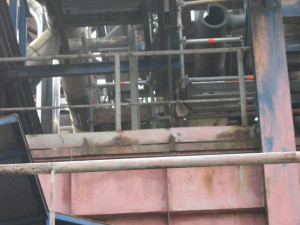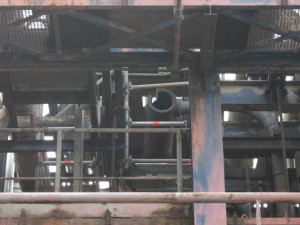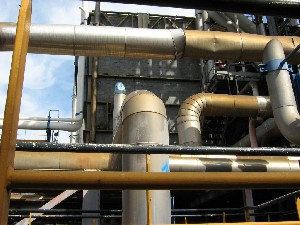At 11:15 pm, a violent and loud bursting occurs within an ammonia (NH3) synthesis unit at a SEVESO-classified nitrogenous fertiliser plant. The convex base welded to a heat-insulated, high-pressure water vapour pipe connected to catalytic reforming equipment had burst prior to ignition. The base, a 40-kg block of steel, was projected longitudinally. Inside the shop area, a walkway was ripped off its supports damaging an access ladder. The steel base crossed the ammonia confinement space 25 m further, without causing any damage, then flew over an ammonium nitrate conveyor belt only to land 230 m away in a parking zone for tanker cars full of ammonia awaiting shipment, which on that day happened to be empty. The water vapour, circulated at 520°C under 120 bar of pressure in the pipeline, tore apart the asbestos cement cladding on the wall located 20 m from the original rupture and escaped into the atmosphere with a load accompanying noise. The two employees present in the unit at the time cut off vapour supply to stop the sound, shut down production operations and cooled the steam reformer with nitrogen. At 11:50 pm, the plant’s internal emergency plan was activated by the operator, yet he failed to sound the siren or notify neighbouring localities. Alerted by the outside noise, local residents called emergency services around midnight; first responders arrived onsite with a crew of 55 men and several utility vehicles. No intervention was required on their part. Upon hearing the vehicle sirens, some residents stepped out onto their balconies or made their way to the periphery of the plant since the municipality was unable to provide information about the ongoing incident. No victims were reported and the site’s other units were not adversely affected; no operations had to be interrupted. The damaged unit was shut down for several weeks, which in turn caused shutdowns at special fertiliser production units due to the loss of vapour.The site operator only reported a slight amount of rust at the level of the break in the convex support and a hole on the inner wall of the outlet tube. A metallurgical assessment of the base indicated that slow creep had initiated on the outer skin, which combined with flow into the material layer was the cause of pipe rupture. This hypothesis relied on the detection of oxidised, yet non-deformed, pipe openings in the presence of intergranular microcracks on both the pipe and its base. The origin of this creep was explained by the metallurgical composition of the base, i.e. ordinary carbon steel containing no alloys and not adapted to temperatures above 425°C. The pipeline was made of a slightly-alloyed P22 type steel, which was more resistant to creep and compliant with the original specifications defined 32 years prior for both material elements. Inspections carried out at the time on the convex base did not detect any noncompliance of the steel, given that non-destructive technology had not yet come of age. This creep might have been accelerated as a result of heat treatment performed at 700°C during equipment installation, once the assembly had been welded. Periodic inspections dedicated to pressurised equipment on the damaged pipe were only recorded into the log 25 years after service start-up, at the time of applying for facility recertification. The initial recertification was rendered official without any underlying structural documentation (misplaced), and subsequent inspections never focused on the section of pipe that would burst.Nine months before the accident, the in-house inspection team had requested adding the mode of “degradation by high-pressure vapour pipe vibrations” to the unit’s pipe inspection routine, following a break in the drain valve of a high-pressure pipe when restarting operations at the unit. On the day of the accident, this mode had not been included in the inspection programme. Classified Facilities inspectors requested a materials control of all unit pipes before restarting operations; this additional step revealed 12 other noncompliant steel components (a tee junction, tap, base, flange, etc.).
Download the detailed report in .pdf format (709 Kb)







